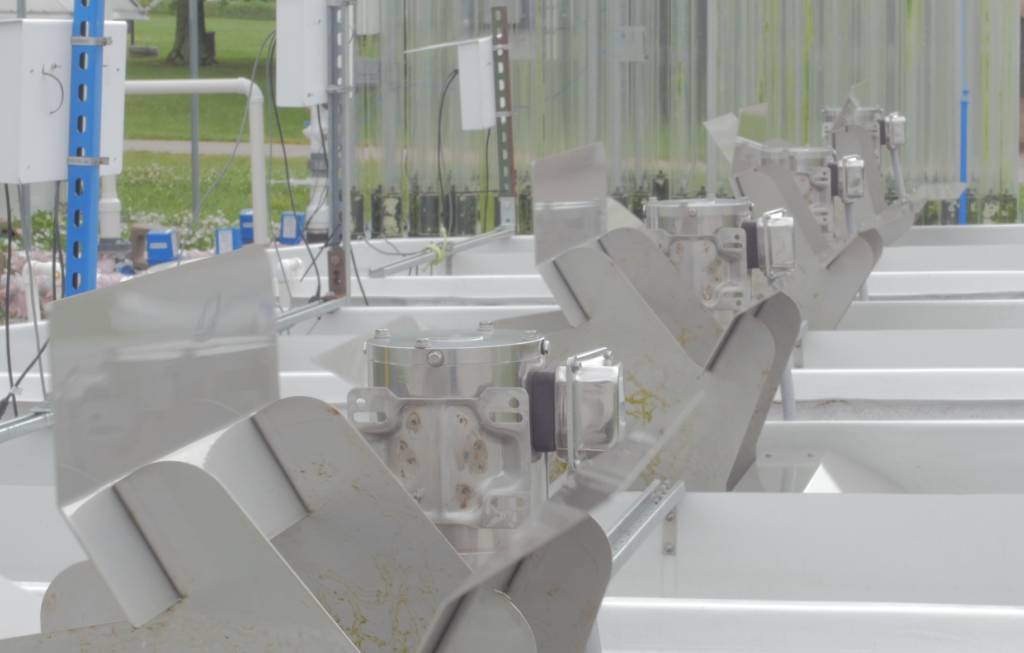For over 10 years, researchers at UK’s Center for Applied Energy Research have implemented more efficient ways to capture carbon emissions from point sources using a system based on algae. And while the research itself is phenomenal, the researchers behind it are equally amazing. Utilizing a solvent system, researchers are able to capture carbon emissions while simultaneously fostering the growth of algae, an incredibly flexible organism.
Algae isn’t a plant or an animal; it is a single-cell organism that replicates quickly. The speed with which algae grows is one of its greatest features, since algae captures carbon as it grows through photosynthesis. Algae can then be used by researchers in many ways. In years past, harvested algae were dried and sent to Algix, an algae processing company, to be converted into bioplastics, including materials used in shoes. This is just one example of ways in which industries are using algae.
The algae program began just a little over a decade ago. CAER researchers began researching algae on site, and as the algae grew, so did their knowledge. Test tubes turned into photobioreactors and open raceway ponds, and the project was only getting started. Eventually, this work resulted into several million dollars plus research projects funded by the U.S. Department of Energy (DOE). Each of these DOE-funded projects supported collaborations between UK CAER, UK’s College of Engineering, as well as other universities and companies, supporting researchers like Julia Parker, a staff researcher at CAER, and Zach Sears, a UK undergraduate researcher. These researchers continue to work day-in and day-out and their research is acknowledged widely.
Julia grew up in Suwanee, GA and began her involvement in research in 2018 when she started working at CAER while pursuing her degree in Biosystems and Agricultural Engineering (BAE). She initially joined CAER as an undergraduate research assistant working on the algae project, which eventually led her to focus on renewable energy research. During her time at CAER, Julia received support for her undergraduate research from the Kentucky-West Virginia Louis Stokes Alliance for Minority Participation and a grant from the National Science Foundation’s Broadening Participation in Engineering program. This support also allowed her to attend a summer school in 2019 at the Reiner Lemoine Institute in Berlin, Germany, focused on renewable energy applications. “After graduating in 2019, I pursued a Master’s degree in BAE and conducted my thesis research at UK CAER, focusing on the conversion of biomass as an alternative to petroleum-derived chemicals to reduce our dependence on fossil fuels,” said Parker. Upon completing her Master’s degree, Julia took on the role of assistant research engineer joining the ongoing algae project and serving as the lab supervisor for the labs of the Sustainable and Alternative Fuels (SAF) group of CAER.

The process from scaling up algae cultures from test tubes to several open raceway ponds is long and demanding. First, the researchers at CAER start working with test tubes of an algae strain native to Kentucky. Next, researchers transfer some of that algae to a clean and nutrient-dense bioreactor so the organism can continue to grow. The algae are extremely delicate at this point and its growth must be carefully monitored. The algae are then used to seed a larger bioreactor. Throughout, researchers must be extremely diligent to keep all material to be used completely sterile to minimize or avoid contamination from any other microorganisms. The process is tedious and detail-oriented, reflecting the grit and determination of the researchers behind it.

To prevent a failed batch of algae, there are countless things that have to go correctly. This adds additional pressure on researchers when handling the algae. There is an optimal ratio of nutrients to supply to the algae to keep it growing at a good rate. Successfully getting the algae to a larger bioreactor is difficult but keeping it healthy once it’s there is also a challenge.
“My greatest challenge has been working around unforeseen equipment malfunctions. From something small and temporary like the freeze dryer not vacuuming, to something big and longer lasting like the autoclave breaking down. Although it might set us back a bit or interrupt the flow of work, we always find a way to feed our algae and collect the data we need by persevering and thinking creatively with the help of the group”.
Zach Sears, student researcher
Zach joined the algae project in early May. His job in the SAF group is to keep the algae alive and collect data on the raceway ponds, namely temperature, pH, and nitrogen concentration. At 9 a.m., the group takes morning measurements, checking how these variables and pond depth have changed since the previous day. After collecting samples, a sample of algae from each pond is taken back to the lab to determine the density of the culture spectroscopically. On Monday, Wednesday, and Friday, Zach determines the density of the ponds via dry mass measurements, eliminating water and weighing the mass of dry algae. Additionally, some of the algae is freeze dried so a chemical analysis can be performed on it, determining the amount of carbon, hydrogen, oxygen, and nitrogen it contains. The group ends the day by taking final afternoon measurements. Oftentimes, the work is tedious and the working conditions in the greenhouse can be uncomfortably hot; however, that doesn’t prevent Zach and his team from continuing to work diligently on this project.

“Julia and Zach are continuing a proud history of algae research here at CAER. This work got its start under the leadership of longtime CAER Associate Director Mark Crocker. Many students and professional researchers – including Stephanie Kesner, Robby Pace, Madeline McDermott and Norman Chan – have been keeping both algae and algae research alive at CAER for years.”
Dave Melanson, Assistant Director for External Affairs and Development at CAER
To learn more about the work Julia, Zach, and many others have invested into the algae research, check out the biosystems section of our website at https://caer.uky.edu/biofuels-environmental-catalysis/.



























